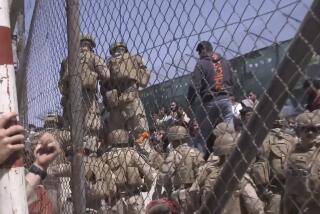Troops Secure City Airport at Kandahar
- Share via
WITH THE MARINES IN SOUTHERN AFGHANISTAN — In a complex and fast-paced operation late Thursday, hundreds of U.S. Marines assumed control of the city airport near the former Taliban stronghold of Kandahar.
With some Marines landing in helicopters and others racing through the streets of Kandahar in armored vehicles, troops from Camp Pendleton and Camp Lejeune, N.C., took hold of the abandoned facility without any shots being fired.
The Marines used surprise, speed, planning and the advantage of night-vision goggles on a moonless night to avoid confrontation with remnants of the once-strong Taliban and Al Qaeda forces.
The Marines plan to make the airport suitable both for planes involved in the humanitarian airlift of food, medicine and other supplies for Afghans, many of whom face starvation this winter, and for military transport aircraft.
By taking hold of the airport, which is about 12 miles south of the city, the Marines helped solidify anti-Taliban forces’ control over a major part of Afghanistan.
“These are professionals going to work,” Lt. Col. Jerome Lynes of Camp Lejeune said of the Marines, many barely out of their teens. “They’re young, but they’re resolute.”
Navy Seabees from Gulfport, Miss., immediately began inspecting the 4,000-foot runway and devising ways to repair its many potholes and craters, some resulting from the fierce fighting there between Afghan opposition forces and the Taliban army.
Before the operation, at a briefing for top officers at Camp Rhino, the Marine outpost less than 80 miles south of the city, Brig. Gen. James N. Mattis said he had met secretly with Hamid Karzai, who is expected to take office next week as Afghanistan’s interim prime minister.
“Twice my country has needed you,” Karzai told Mattis. “First to save us from the Soviets, now from the terrorists.”
Even though reconnaissance forces had scouted the area for days, Marines were concerned about the possibility of gunfire, land mines and booby traps.
“You can’t get sloppy, you can’t get lackadaisical,” Maj. Wesley Feight, a company commander from Camp Lejeune, told his troops.
After two decades of war, much of the Afghan population is heavily armed and remains so, despite attempts by the Marines and opposition forces to seize weapons from Taliban soldiers.
Marines also were warned that Taliban or Al Qaeda soldiers might be armed with shoulder-launched surface-to-air Stinger missiles and hiding in the city’s irrigation canals, waiting for a chance to mount an ambush.
Concerned about the possibility that Marines might confuse friendly Afghan troops with enemies, the force brought interpreters who speak Pashto, Urdu, Persian and Arabic. The U.S. troops were also accompanied by some allied Afghan fighters and Australian forces. Marines were cautioned not to confuse fireworks with gunfire.
“It’s the end of [the Muslim holy month of] Ramadan; they’re going to be using fireworks,” said Col. Andrew P. Frick, commander of the Camp Lejeune-based 26th Marine Expeditionary Unit. “Make sure it’s aimed at us before you engage.”
Kandahar, a major crossroads since ancient times, is the second-largest city in Afghanistan. It is on the highway between Iran and Pakistan. The airport gives the Marines added control over the central part of Afghanistan.
The city has a long history of being visited by foreign armies. Founded by Alexander the Great in the 4th century BC, the city was fought over by Indians and Persians, conquered by Arabs in the 7th century, sacked by Genghis Khan in the 12th century and occupied by the British for several years in the 19th century.
In the civil war of the 1990s, the Taliban emerged victorious in Kandahar and enjoyed a measure of acceptance among the war-weary population.
Marine “hunter-killer” teams, backed by U.S. warplanes, helped opposition forces defeat the Taliban last week in the battle for Kandahar, then switched their attention to closing off avenues of escape and capturing key Taliban and Al Qaeda leaders.
Mattis and many of the Marines from Camp Pendleton have been at Camp Rhino since the outpost was seized Nov. 26.
The Marines from Camp Lejeune began arriving at Camp Rhino by helicopter from the amphibious assault ship Bataan on Thursday morning.
Within hours they were being airlifted into Kandahar for the airport operation.
Marine spokesmen said the operation shows the ability of their forces to function far from coastal areas. As an amphibious force, the Marine Corps is thought to perform best within 300 miles of the shoreline. But Camp Rhino and Kandahar are more than 400 miles from the northern Arabian Sea.
“The Marine Corps exceeded America’s expectations during the [1991 Persian] Gulf War when we sped through and liberated Kuwait City,” said Capt. David Romley, spokesman for the Camp Pendleton-based 15th Expeditionary Unit. “We have done it again by rapidly stretching inland to secure Kandahar.”
Romley brought a full-sized U.S. flag given to him by his mother, Patti Simcoe, of San Diego.
The Camp Lejeune Marines brought a flag signed by family members of some of the victims of the Sept. 11 attacks.
“God’s taking care of us. [We’re] doing our job,” said Cpl. Edgar Zapata of Camp Lejeune.
More to Read
Sign up for Essential California
The most important California stories and recommendations in your inbox every morning.
You may occasionally receive promotional content from the Los Angeles Times.













